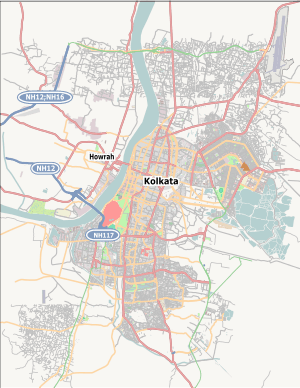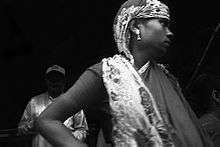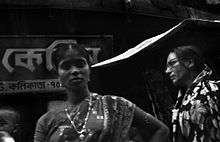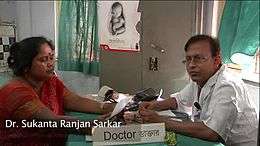Sonagachi
| Sonagachi | |
|---|---|
 Sonagachi Location in Kolkata | |
| Coordinates: 22°35′15″N 88°21′35″E / 22.58750°N 88.35972°ECoordinates: 22°35′15″N 88°21′35″E / 22.58750°N 88.35972°E | |
| Country |
|
| State | West Bengal |
| City | Kolkata |
| Elevation | 11 m (36 ft) |

Sonagachi is reputedly South Asia's and hence simultaneously India's largest[1] red-light district. Sonagachi is located in Kolkata, India. Its area contains several hundred multi-story brothels and an estimated 11,000 sex workers (2012).[2][3] Sonagachi is located in North Kolkata near the intersection of Chittaranjan Avenue and Shobhabazar with Beadon Street, about one kilometer north of Kolkata's Marble Palace area.
Etymology
There are some legends that this area was owned by Sanaullah Gazi. Sanaullah or Sona Gazi was a Muslim saint. His tomb still remains as Mazar there. The area also was named after him, later the name changed to current one.
Current situation
Today, several NGOs and government organizations operate here for the prevention of sexually transmitted diseases (STD) including AIDS. The book Guilty Without Trial by the founders of the NGO Sanlaap based much of their research into human trafficking in India on this area.

The Sonagachi project is a sex workers' cooperative that operates in the area and empowers sex workers to insist on condom use and to stand up against abuse. Run by the Durbar Mahila Samanwaya Committee It was founded by public health scientist Smarajit Jana in 1992 but is now largely run by the prostitutes themselves. While some are crediting DMSC with keeping a relatively low rate of HIV infection among prostitutes in Sonagachi—5.17% of the 13,000 prostitutes in Sonagachi are estimated to be HIV positive [4]—this HIV rate is in fact no different than the average HIV rate for female prostitutes in India, which is estimated to be 5.1% [5] (the HIV rate infection among prostitutes as well as among the general population varies widely by region in India).
According to some sources, prostitutes from Sonagachi who test HIV positive are not told about the results, and live with the disease without knowing about it "because the DMSC is worried that HIV positive women will be ostracized."[6] Some prostitutes in Sonagachi have stated that "the clients, at least three quarters of them" refuse to use condoms and "if we force them to use the condom, they will just go next door. There are so many women working here, and in the end, everyone is prepared to work without protection for fear of losing trade.”[6]
Besides the Sonagachi project, (DMSC) also runs several similar projects in West Bengal, organizing some 65,000 prostitutes and their children. The organization lobbies for the recognition of sex workers' rights and full legalization, runs literacy and vocational programs, and provides micro loans.[7][8] The DMSC hosted India's first national convention of sex workers on 14 November 1997 in Kolkata, titled 'Sex Work is Real Work: We Demand Workers Rights'.[9] The book Half the Sky: Turning Oppression into Opportunity for Women Worldwide reports investigations revealing that, contrary to stated policy, the DMSC allows sex slavery, trafficking, and underage girls in Sonagachi project brothels.[10]
Popular culture

The documentary Born into Brothels: Calcutta's Red Light Kids won the Oscar for best documentary feature in the year 2005. It depicts the lives of children born to prostitutes in Sonagachi. "Born into Brothels" is a documentary that takes the viewer beyond the well-known prostitute-clogged streets and into the homes of the children who live in the so-called worst place on earth. If the film has one success story, it's the discovery of ten-year-old Avijit whose natural affinity for creating exciting compositions through the lens earned him an invitation to the World Press Photo Foundation in Amsterdam.
There is also a documentary titled Tales of The Night Fairies by Prof. Shohini Ghosh and Dr. Sabeena Ghadioke from Asia's leading Media institute AJK, Mass Communication Research Centre, about the Sonagachi area. It has won the Jeevika Award for the best documentary feature on livelihood in India.[11]
Popular actor Kamal Haasan's movie Mahanadhi has a storyline based on the area.The Malayalam Film Calcutta News depicts the story of women being trafficked and forced to become sex worker in Sonagachi.[12]
In his documentary The Five Obstructions, renowned Danish filmmaker Lars von Trier asks poet and experimental filmmaker Jorgen Leth to name the worst place in the world he's ever visited, and immediately Leth responds with "The Red Light District of Calcutta."
References
- ↑ Rohit Bhattacharya (2 May 2015). "8 Largest Red Light Areas Across India". ScoopWhoop. Retrieved 17 March 2016.
- ↑ "The new rhythms of Sonagachi: As the city's sex workers collective turns 20...". Mint (newspaper). 24 February 2012.
- ↑ Girl-trafficking hampers Aids fight BBC news. 30 November 2004
- ↑ "In Sonagachi, keeping HIV away a daily battle". Indian Express. 2009-12-02. Retrieved 2012-07-12.
- ↑ "India HIV & AIDS Statistics". Avert.org. Retrieved 2012-07-12.
- 1 2 "Welcome to Sonagachi – Calcutta's largest brothel area is thriving". Tom Vater. 2004-05-12. Retrieved 2012-07-12.
- ↑ durbar.org, home page of the Durbar Mahila Samanwaya Committee
- ↑ "DEAD ZONES: Fighting Back in India.; Calcutta's Prostitutes Lead the Fight on AIDS". New York Times. 4 January 1999.
- ↑ Sex work is real work: We demand workers rights, announcement of the 1997 sex worker convention Archived 12 December 2006 at the Wayback Machine.
- ↑ Kristof, Nicholas D.; Sheryl WuDunn. 2009. Half the Sky: Turning Oppression into Opportunity for Women Worldwide
- ↑ "Welcome to AJK Mass Communication Research Centre". Ajkmcrc.org. Retrieved 2012-07-12.
- ↑ "review of the film Calcutta News".
External links
- Report on Sonagachi, critical of DMSC, by Tom Vater, The Irish Independent, 2004.
- The Red Lights of Sonagachi Positive Nation, Dec 2003/Jan 2004; issue 85/86 (Dead link)
- Report on the Dunbar NGO, India Travel Times
- The Sex Workers, 2004 PBS Frontline documentary comparing anti-HIV efforts in Mumbai and Kolkata
- Giving AIDS the Red Light, The Village Voice, 18 September 2002
- Changing prices for sex work in Sonagachi, a Kolkata red-light district
- Living with dignity: an international development cooperation story for the Wikibook
 Development Cooperation Handbook.
Development Cooperation Handbook.
